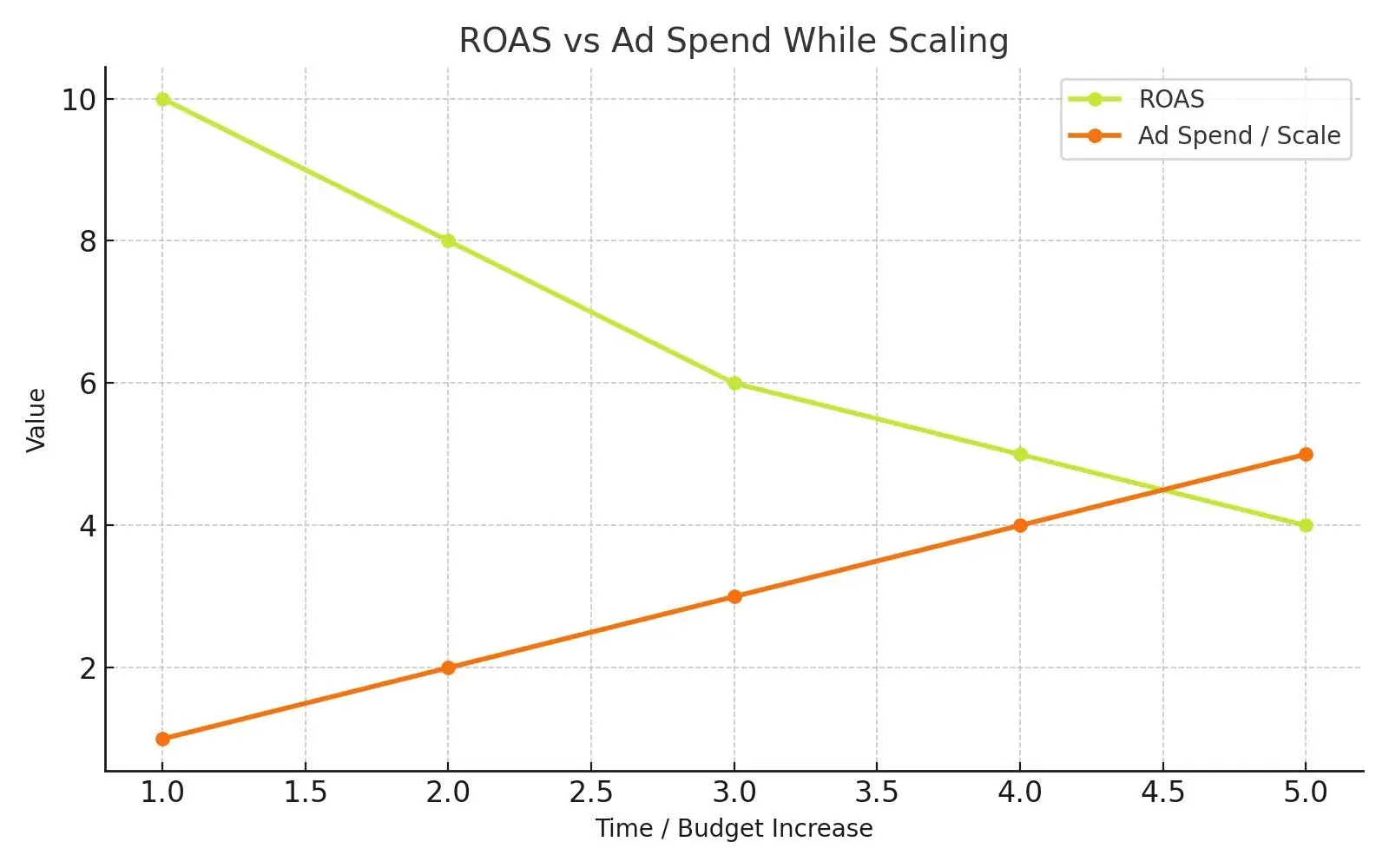One of the biggest misconceptions about how to scale a DTC brand is believing that ROAS and scaling go hand in hand. They don’t. In reality, they often work against each other.
We know that ROAS – from a brand’s perspective when working with an agency – is not the most accurate metric since the agency fee is an additional cost alongside ad spend. However, ROAS remains a widely known and trusted metric, so we take a closer look at how to maximize it and what happens when a brand aims for massive scaling.
The ROAS vs. Scaling Dilemma
At Evolut, we’ve worked with brands across beauty, supplements, and fashion categories, and we’ve seen one thing repeatedly:
Focusing purely on ROAS can limit growth.
When it comes to how to scale a DTC brand, you need to make a clear choice. Either prioritize maximizing ROAS or commit to aggressive scaling. Trying to do both at once is a recipe for failure.
The Inevitable ROAS Drop When Scaling
Let’s say your campaign is hitting 10X ROAS at a $10,000 monthly ad spend. You decide to double your budget to $20,000.
What happens?
- Your original high-ROAS audience is already maxed out.
- Facebook, TikTok, or Google now push your ads to a broader, less-converting audience.
- Your CAC (Customer Acquisition Cost) goes up, and your ROAS drops to 6X or 7X.
The same thing happens even if your creatives are top-notch. It’s just how media buying works.
So How to Scale a DTC Brand?
The answer depends on your business goals.
Are you prioritizing profitability and efficiency or aggressive growth and market share?
The two require fundamentally different approaches.
If Profitability is Your Priority → Maintain High ROAS
This strategy is about keeping ad spend efficient while maximizing the revenue from your existing customers. It works best for brands with high profit margins, strong organic growth, or limited inventory.
How to Maintain High ROAS Without Sacrificing Growth
Stick to bottom-of-funnel (BOFU) audiences. Past buyers, engaged users, and high-intent lookalikes. Also, focus on the most effective ad placements, such as Instagram/Facebook Feed and Stories, or Google Shopping results. These convert better and help maintain efficiency.
A strong email and SMS marketing strategy can increase the average order value (AOV) and customer lifetime value (LTV), reducing reliance on expensive paid acquisition.
Test ad variations, optimize messaging for conversions, and double down on creatives that consistently perform well.
If your strongest return is coming from Google Shopping, Meta retargeting, or TikTok Spark Ads, concentrate your budget there rather than spreading it too thin.
Also, focus on your high-ROAS campaign types such as branded search, Performance Max (especially feed-based PMax), or social DPA (Dynamic Product Ads).
Scaling aggressively will almost always lead to increased CAC and lower ROAS. If your primary concern is maintaining profitability, only scale when your existing campaigns are fully optimized and profitable at the current spend.
If Growth is Your Priority → Accept a Lower ROAS While Scaling
If your goal is to capture more market share, build brand awareness, and create long-term value, you need to be comfortable with temporary inefficiencies in ad spending. Learning how to scale a DTC brand means accepting higher short-term costs in exchange for greater long-term rewards.
How to Scale Without Losing Control of ROAS
Rapid scaling can break your performance. Instead, increase the budget incrementally (e.g., by 20-30% every few days) and monitor how the platform adapts.
Short-term ROAS will likely dip, but if repeat purchase rates and LTV improve, scaling will pay off in the long run.
Vertical Scaling: Increase the budget of high-performing ad sets, but be mindful of hitting a performance ceiling.
Horizontal Scaling: Introduce new ad sets targeting different audiences or placements to reduce risk and discover new profitable segments.
A combination of both methods helps sustain growth without rapidly increasing costs.
A streamlined campaign structure can improve scalability while maintaining performance. Instead of managing too many segmented campaigns, focus on fewer, higher-performing ones. A well-structured setup ensures smoother scaling without unnecessary fragmentation.
Move beyond retargeting and core lookalikes – test broad targeting, interest-based audiences, and prospecting campaigns to bring in new customers.
Relying solely on Meta or Google will cap your growth. Diversify ad spending across multiple platforms to reach new segments before they convert on your main channels.
Creatives optimized purely for direct response (DR) ads often don’t work at scale. Instead, incorporate educational, emotional, and authority-driven content to warm up colder audiences.
Final Thought: The ROAS Sweet Spot for Scaling
A brand that stays too conservative with ROAS never grows. A brand that scales too aggressively risks profitability. The key to how to scale a DTC brand is finding the right balance, profitably acquiring new customers while maximizing their lifetime value.
This means aligning performance goals with long-term brand equity – leveraging data, creative strategy, and retention channels to support sustainable growth without sacrificing margins.

















